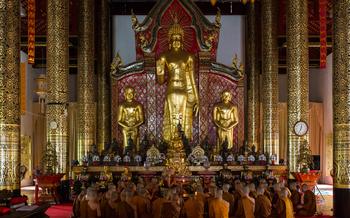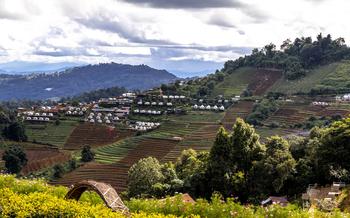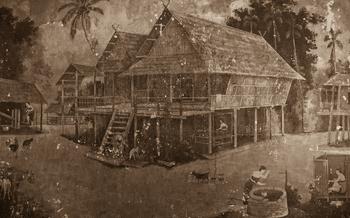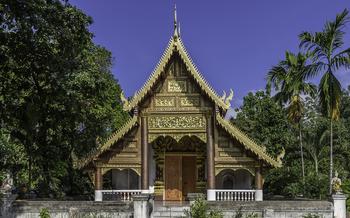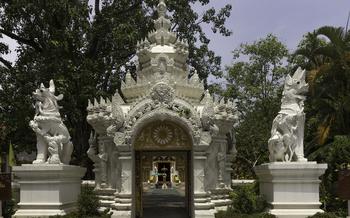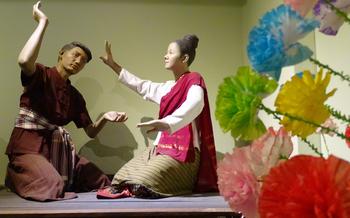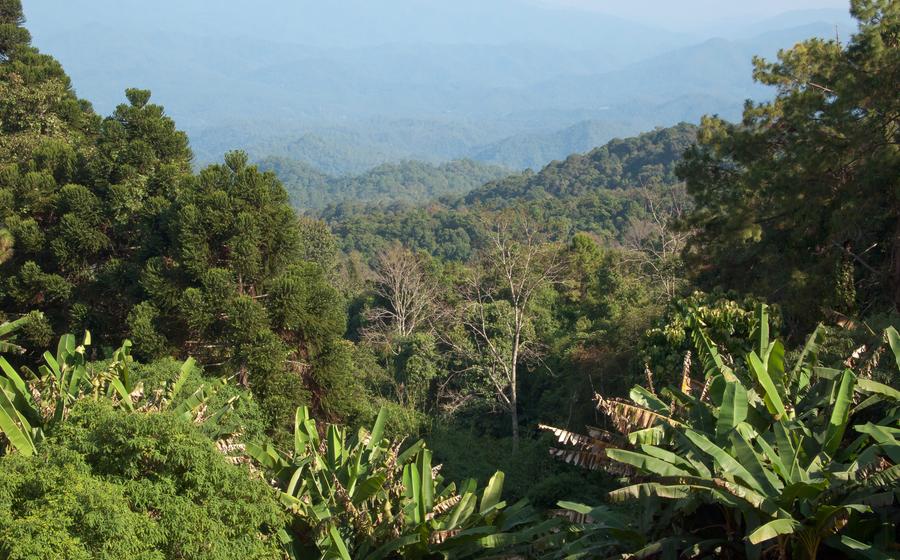
Doi Suthep Pui National Park
- Doi Suthep Pui National Park: A Haven of Natural Wonders
- Exploring the Park: A Journey through Diverse Ecosystems
- Doi Suthep Temple: A Sacred Landmark
- Historical Significance
- Architectural Features
- Religious and Cultural Importance
- Stunning Views from the Temple Grounds
- Bhubing Palace: A Royal Retreat
- Pha Lat Waterfall: A Cascading Beauty
- Mon Cham: A Thriving Hmong Village
- Wat Palad: A Temple with a Unique Charm
- Doi Pui Village: A Mountaintop Community
- Elephant Nature Park: A Sanctuary for Gentle Giants
- Orchid and Butterfly Farm: A Burst of Colors
- Strawberry Fields: A Taste of Sweetness
- Doi Suthep-Pui National Park Museum: A Journey into History
- Local Markets: A Cultural Shopping Spree
- Street Food Delights: A Culinary Adventure
- Insider Tip: The Best Time to Visit
Doi Suthep Pui National Park: A Haven of Natural Wonders
Nestled amidst the picturesque highlands of northern Thailand, Doi Suthep Pui National Park stands as a testament to the country's rich natural heritage. Established in 1981, the park encompasses a diverse landscape that ranges from towering mountains to lush forests, sparkling waterfalls, and serene temples. With an area spanning over 260 square kilometers, it offers visitors a chance to immerse themselves in the beauty and tranquility of nature.
History and Background
The history of Doi Suthep Pui National Park is deeply intertwined with the cultural and religious traditions of the region. The park's most prominent landmark, Doi Suthep Temple, was constructed in the 14th century and is considered one of Thailand's most sacred Buddhist sites. The temple's construction is attributed to King Ku Na, who was inspired by a dream in which a white elephant carried a sacred relic to the summit of Doi Suthep.
Geographical Location
Doi Suthep Pui National Park is situated approximately 15 kilometers west of Chiang Mai, the capital of northern Thailand. It forms part of the Thanon Thong Chai mountain range and is bordered by the Ping River to the east. The park's strategic location provides easy access for visitors from Chiang Mai, making it a popular destination for day trips and weekend getaways.
Size and Landscape
Doi Suthep Pui National Park covers an extensive area of 265 square kilometers. The park's landscape is characterized by a diverse topography, ranging from the towering peak of Doi Suthep (1,676 meters) to the lush valleys and forests that surround it. The park's highest point, Doi Pui, stands at 1,685 meters and offers breathtaking panoramic views of the surrounding countryside.
Conservation Efforts
Doi Suthep Pui National Park is a vital sanctuary for a wide range of plant and animal species. The park's diverse habitats support a variety of flora and fauna, including endangered and threatened species. Conservation efforts within the park focus on protecting these species and their habitats, while also promoting sustainable tourism practices that minimize the impact on the environment.
Exploring the Park: A Journey through Diverse Ecosystems
Doi Suthep Pui National Park encompasses a remarkable diversity of habitats, ranging from lush rainforests to towering mountains, creating a sanctuary for a rich variety of flora and fauna. As you embark on the park's hiking trails, you'll encounter a tapestry of vibrant ecosystems, each offering its own unique wonders.
The park's forests are a treasure trove of plant life, with towering trees, delicate orchids, and an abundance of ferns and mosses carpeting the forest floor. Keep an eye out for the park's signature flower, the Lady's Slipper Orchid, with its unique slipper-shaped petals.
The park is also home to a diverse array of wildlife, including monkeys, gibbons, squirrels, and a variety of bird species. Birdwatchers will delight in the opportunity to spot colorful birds such as hornbills, sunbirds, and woodpeckers flitting through the forest canopy.
Hikers of all levels will find trails to suit their abilities, ranging from gentle walks through the forest to challenging climbs to the park's highest peaks. Along the way, you'll be rewarded with breathtaking viewpoints that offer panoramic vistas of the surrounding mountains and valleys.
Whether you're an experienced hiker or a nature enthusiast looking for a leisurely stroll, Doi Suthep Pui National Park offers an unforgettable journey through its diverse ecosystems, promising encounters with the wonders of the natural world.
Doi Suthep Temple: A Sacred Landmark
Doi Suthep Temple, nestled atop Doi Suthep mountain, is the crowning jewel of Doi Suthep Pui National Park. Steeped in religious and historical significance, the temple dates back to the 14th century and is considered one of the most sacred Buddhist sites in northern Thailand.
Historical Significance
Legend has it that the temple was built following a white elephant carrying a holy relic of the Buddha's shoulder bone to the mountain's summit. This auspicious event prompted the construction of a chedi, or Buddhist stupa, to enshrine the relic and honor the sacred spot.
Architectural Features
The temple complex showcases a blend of Lanna and Burmese architectural styles. The main highlight is the towering golden chedi, adorned with intricate carvings and gleaming stupas. Visitors can ascend the grand staircase flanked by mythical serpent statues, known as naga, leading to the chedi's base.
Religious and Cultural Importance
Doi Suthep Temple is a significant pilgrimage site for Buddhists from around the world. Devotees flock to pay homage to the sacred relics and seek blessings. The temple also hosts annual festivals and ceremonies, attracting thousands of visitors who come to celebrate and immerse themselves in the vibrant Lanna culture.
Stunning Views from the Temple Grounds
Beyond its religious significance, Doi Suthep Temple offers breathtaking panoramic views of the surrounding landscape. From the temple grounds, visitors can marvel at the sprawling city of Chiang Mai, the lush green valleys, and the majestic mountain ranges stretching into the distance. The serene atmosphere and stunning vistas make it an ideal spot for contemplation and spiritual reflection.
Bhubing Palace: A Royal Retreat
Nestled amidst the lush forests of Doi Suthep Pui National Park, Bhubing Palace stands as a testament to the architectural heritage and royal legacy of Thailand. Commissioned by King Rama V in 1897 as a summer residence, this elegant palace exudes an aura of tranquility and charm.
Designed in a blend of traditional Thai and European architectural styles, Bhubing Palace showcases intricate woodwork, delicate stucco ornaments, and beautifully painted eaves. The main building, known as Wang Bhubing, features a spacious reception hall, royal chambers, and a grand dining room. The intricate carvings and murals adorning the walls depict scenes from Thai mythology and history, offering a glimpse into the kingdom's rich cultural heritage.
Surrounding the palace are lush gardens meticulously landscaped with fragrant flowers, ornamental plants, and towering trees. Gentle pathways meander through the serene grounds, leading visitors to hidden corners and secluded spots, offering panoramic views of the surrounding mountains and valleys.
Today, Bhubing Palace serves as a royal retreat and occasionally hosts official functions and events. Visitors can explore the palace grounds and admire its architectural beauty from afar, as the interior remains reserved for the royal family's private use. The palace stands as a symbol of Thailand's monarchy, a reminder of its enduring traditions and the deep respect accorded to the royal lineage.
Pha Lat Waterfall: A Cascading Beauty
Nestled amidst the lush greenery of Doi Suthep Pui National Park, Pha Lat Waterfall beckons visitors with its enchanting allure. Located approximately 5 kilometers from the park headquarters, this cascading wonder is a true hidden gem, inviting adventurers to immerse themselves in its pristine beauty.
To reach Pha Lat Waterfall, visitors can embark on a scenic hike through the park's verdant trails. The moderate trek offers breathtaking views of the surrounding landscape, with lush forests, cascading streams, and towering mountains providing a backdrop for your journey. Once you arrive at the waterfall, you will be greeted by the mesmerizing sight of water cascading down a series of rocky ledges, creating a symphony of sound and motion.
The waterfall's plunge pool invites visitors to take a refreshing dip and bask in the tranquility of the surroundings. Surrounded by lush vegetation, the pool offers a serene oasis where you can relax and soak up the beauty of nature.
The area surrounding Pha Lat Waterfall is equally captivating. Visitors can explore the nearby trails, which lead to hidden viewpoints that offer panoramic vistas of the park. The lush vegetation provides a habitat for a diverse array of flora and fauna, making it an ideal spot for nature enthusiasts to observe and appreciate the park's rich biodiversity.
Mon Cham: A Thriving Hmong Village
Nestled amidst the lush green hills of Doi Suthep Pui National Park, Mon Cham stands as a vibrant and thriving Hmong village, welcoming visitors with open arms to experience their rich cultural heritage and traditions. The village is home to the Hmong people, an ethnic group renowned for their colorful attire, intricate embroidery, and deep-rooted connection to nature. As you step into Mon Cham, you'll be captivated by the authentic atmosphere, where locals go about their daily lives, showcasing their unique customs and way of life.
The village is a treasure trove of handicrafts and local products. Hmong women are skilled artisans, creating exquisite handmade textiles, embroidered bags, and traditional clothing. Visitors can witness the intricate craftsmanship and purchase these beautiful items as souvenirs or gifts. Moreover, Mon Cham offers a glimpse into the Hmong's agricultural practices. The surrounding hillsides are dotted with terraced fields where they cultivate rice, vegetables, and fruits, using traditional methods passed down from generation to generation.
For a truly immersive experience, consider staying in one of the village's homestays. This is an excellent opportunity to learn about Hmong culture firsthand, share meals with local families, and participate in daily activities. Homestays not only provide a unique insight into their way of life but also contribute to the village's economy and sustainability. By visiting Mon Cham, you'll not only discover the beauty of the national park but also gain a deeper understanding of the fascinating Hmong culture.
Wat Palad: A Temple with a Unique Charm
Nestled amidst the lush greenery of Doi Suthep Pui National Park, Wat Palad is a serene and captivating temple that exudes a unique charm. Its history dates back to the 14th century, making it one of the oldest temples in the region. The temple is renowned for its intricate architectural features, which blend traditional Lanna and Burmese styles. Adorned with beautifully carved wooden structures, delicate stuccowork, and colorful murals, Wat Palad is a testament to the artistic prowess of its creators.
Inside the temple, visitors are greeted by an array of Buddha images and sculptures, each with its own distinct features and expressions. The main Buddha image, known as Phra Chao Thong, is particularly revered by locals and is believed to possess miraculous powers. The temple grounds offer a peaceful and tranquil atmosphere, inviting visitors to sit in meditation or simply soak in the serene surroundings. With its rich history, stunning architecture, and spiritual significance, Wat Palad is a must-visit destination for anyone exploring Doi Suthep Pui National Park.
Doi Pui Village: A Mountaintop Community
Nestled amidst the verdant slopes of Doi Suthep, the enchanting village of Doi Pui is a living testament to the vibrant cultural diversity that graces this region. Home to various ethnic groups, including the Hmong, Karen, and Akha, this mountaintop community exudes a palpable sense of authenticity and charm. Visitors are warmly welcomed into the lives of these indigenous people, who have preserved their unique traditions and customs over generations.
Explore the narrow cobblestone streets, where colorful houses adorned with intricate carvings and vibrant murals line the way. Interact with the friendly locals, who are always eager to share stories about their rich heritage and way of life. Admire the skillful craftsmanship of the villagers, as they create intricate textiles, silver jewelry, and other traditional handicrafts that showcase their artistic prowess.
Immerse yourself in the agricultural practices of Doi Pui, where the villagers cultivate terraced fields, growing a variety of crops, including strawberries, cabbage, and flowers. Learn about their sustainable farming techniques and witness the beauty of the changing seasons as the landscape transforms with vibrant hues.
Hike to the summit of Doi Pui, the highest peak in the national park, and be rewarded with breathtaking panoramic views that stretch for miles. From this vantage point, you can marvel at the vast expanse of the surrounding mountains and valleys, dotted with lush forests and shimmering rivers.
Whether you choose to embark on a guided tour or explore independently, a visit to Doi Pui Village promises an unforgettable encounter with the diverse cultures and traditions that thrive within Doi Suthep-Pui National Park.
Elephant Nature Park: A Sanctuary for Gentle Giants
Within the confines of Doi Suthep Pui National Park, the Elephant Nature Park stands as a beacon of hope and compassion for these majestic creatures. Founded on the principles of ethical treatment and conservation, the park provides a safe haven for elephants rescued from a life of abuse or exploitation, offering them a chance to heal, socialize, and live out their lives in peace.
Visitors to the park can embark on educational tours, gaining insights into the fascinating behavior and intelligence of elephants. These tours are carefully designed to prioritize the well-being of the elephants, ensuring minimal disruption to their natural routines. Instead of riding or interacting with the elephants directly, visitors observe them from a respectful distance, learning about their unique characteristics and the importance of their conservation.
The park also actively engages in elephant rescue and rehabilitation efforts, working tirelessly to rescue elephants from circuses, logging camps, or other forms of captivity. Once at the park, these elephants receive expert veterinary care, nutritional support, and social rehabilitation, helping them to recover from past trauma and reintegrate into a natural herd.
By visiting the Elephant Nature Park, you not only contribute to the welfare of these gentle giants but also support sustainable tourism practices that prioritize animal welfare and conservation. Embrace the opportunity to connect with these magnificent creatures, learn about their plight, and become a part of the movement to protect and preserve them for future generations.
Orchid and Butterfly Farm: A Burst of Colors
Within Doi Suthep-Pui National Park, discover a vibrant haven for nature enthusiasts and lovers of delicate beauty. The Orchid and Butterfly Farm welcomes visitors to immerse themselves in a world of captivating colors and fluttering wings. Located conveniently within the park, the farm offers a sanctuary for a diverse array of orchids and butterflies, showcasing the region's rich biodiversity.
Stroll through meticulously landscaped gardens adorned with vibrant orchids in full bloom. Admire the intricate patterns, graceful shapes, and captivating hues that characterize these exquisite flowers. Learn about their unique adaptations and the vital role they play in the ecosystem.
Observe the graceful dance of butterflies as they flit from flower to flower, their wings shimmering in the sunlight. Discover the fascinating life cycle of these delicate creatures, from egg to caterpillar to chrysalis and finally to the vibrant butterfly that emerges.
The farm is dedicated to the conservation and breeding of these captivating insects. Visitors can witness the meticulous care and expertise involved in ensuring the well-being and sustainability of these species. Educational displays and exhibits provide insights into the biology, behavior, and ecological significance of orchids and butterflies.
Capture stunning photographs as you wander through the gardens, surrounded by a symphony of colors and life. The Orchid and Butterfly Farm offers a unique opportunity to connect with nature and appreciate the intricate beauty of these delicate creatures.
Strawberry Fields: A Taste of Sweetness
Nestled amidst the rolling hills of Doi Suthep Pui National Park, strawberry fields offer a unique and delightful experience for visitors. Located just a short drive from Chiang Mai, these fields are a haven for strawberry lovers, inviting them to immerse themselves in a world of sweet, juicy berries.
Strawberry picking is a popular activity here, allowing visitors to harvest their own strawberries directly from the fields. The farms provide baskets and guidance on how to select the ripest and sweetest berries. Indulge in a feast of freshly picked strawberries, savoring their natural sweetness and aroma.
In addition to strawberry picking, visitors can also purchase fresh strawberries and locally made strawberry products such as jams, jellies, and ice cream. These make for wonderful souvenirs or gifts for loved ones back home.
The scenic surroundings of the strawberry fields enhance the experience, with stunning views of the mountains and lush greenery. Take a break from picking to admire the natural beauty and capture some memorable photos.
Whether you're a strawberry enthusiast or simply looking for a unique and enjoyable experience, Doi Suthep Pui National Park's strawberry fields are a must-visit. Immerse yourself in the sweet flavors of nature, embrace the local culture, and create lasting memories in this idyllic setting.
Doi Suthep-Pui National Park Museum: A Journey into History
Nestled within the lush greenery of Doi Suthep-Pui National Park, the Doi Suthep-Pui National Park Museum stands as a treasure trove of historical artifacts, cultural heritage, and environmental conservation efforts. Established in 1988, the museum offers a fascinating journey into the park's rich past, showcasing its unique ecosystems, diverse wildlife, and the cultural traditions of the local communities.
Through engaging exhibits and interactive displays, visitors can delve into the history of the park, its geological formations, and the diverse plant and animal species that call it home. Artifacts and specimens on display provide a glimpse into the region's natural wonders, including the park's iconic waterfalls, caves, and mountain peaks.
The museum also highlights the cultural heritage of the hill tribes who have inhabited the area for centuries. Visitors can learn about their traditional way of life, customs, and beliefs. Traditional costumes, tools, and handicrafts showcase the rich cultural diversity of the region.
One of the highlights of the museum is the collection of historical photographs that document the park's transformation over the years. These images capture the evolution of the park, from its early days as a royal hunting ground to its designation as a national park in 198
With its educational exhibits, interactive displays, and historical artifacts, the Doi Suthep-Pui National Park Museum offers visitors a comprehensive understanding of the park's natural and cultural heritage. It is a must-visit for anyone interested in the history, ecology, and cultural significance of this remarkable national park.
Local Markets: A Cultural Shopping Spree
When visiting Doi Suthep Pui National Park, don't miss the opportunity to immerse yourself in the vibrant local markets. These bustling marketplaces are a treasure trove of unique handicrafts, fresh produce, and delicious street food. The Chiang Mai Night Bazaar, located near the old city, is a popular spot for souvenirs, clothing, and local delicacies.
For a more authentic experience, head to the Saturday Walking Street Market, which takes place on Wua Lai Road every Saturday evening. Here, you'll find an array of handmade goods, including intricate silver jewelry, colorful woven textiles, and traditional lacquerware. The market is also a great place to sample local street food, with vendors selling everything from grilled meats to sweet desserts.
When shopping at local markets in Thailand, it's important to remember a few tips. First, bargaining is expected, so don't be afraid to haggle for a good price. Second, be mindful of local customs and dress modestly, especially when visiting temples or religious sites. Finally, support the local community by buying directly from vendors and avoiding mass-produced souvenirs.
Street Food Delights: A Culinary Adventure
In Chiang Mai, street food is not just a quick bite, but a way of life. Every corner and alleyway seems to have its own culinary creation, from the ubiquitous pad thai to the fiery khao soi. The city's street food scene is a testament to Thailand's rich culinary heritage, offering a diverse range of flavors and textures that will tantalize your taste buds.
Popular Dishes to Try
When it comes to street food in Chiang Mai, there are a few must-try dishes that you simply cannot miss. Khao soi, a northern Thai curry noodle soup, is a local favorite, with its rich coconut broth, soft egg noodles, and tender chicken. Pad thai, Thailand's national dish, is another popular choice, with its stir-fried rice noodles, vegetables, and choice of protein. Sai ua, a northern sausage made with pork, lemongrass, and kaffir lime leaves, is a unique and flavorful snack.
Vegetarian and Vegan Options
For those with dietary restrictions or preferences, Chiang Mai's street food scene has plenty to offer. Many vendors offer vegetarian and vegan versions of popular dishes, using tofu, tempeh, or vegetables as substitutes for meat. Look for stalls that display signs indicating that they have vegetarian or vegan options available.
Street Food Etiquette and Hygiene
When it comes to street food, it's important to be aware of local etiquette and hygiene practices. Always wash your hands before eating, and use hand sanitizer if soap and water are not available. Be mindful of where you're eating, as some areas may be more crowded or unsanitary than others. If you're unsure about a particular vendor, observe how locals interact with them and follow their lead.
Local Markets and Food Stalls
The best way to experience Chiang Mai's street food scene is to visit the city's many local markets and food stalls. The Chiang Mai Night Bazaar is a popular spot, with dozens of vendors selling everything from grilled meats to fresh fruit. Other notable markets include the Warorot Market, the Chang Klan Road Night Market, and the Saturday Walking Street Market.
Insider Tip: The Best Time to Visit
Timing your visit to Doi Suthep Pui National Park is crucial for an optimal experience. The best time to visit is during the cool and dry season, which runs from November to February. During this period, the weather is pleasant, with average temperatures ranging from 15 to 25 degrees Celsius. The skies are clear, providing excellent visibility for enjoying panoramic views from the park's viewpoints. Additionally, the dry weather makes hiking trails more accessible and enjoyable, reducing the risk of slippery paths.
It's advisable to avoid the rainy season, which lasts from June to October, as heavy rainfall can make trails muddy and slippery, limiting outdoor activities. Moreover, the park tends to be crowded during the Thai New Year holiday in April and the Songkran Festival in April. To escape the crowds and fully immerse yourself in the park's tranquil atmosphere, consider visiting during the shoulder months of March, May, and November.
If you're interested in experiencing local festivals and events, plan your visit accordingly. The Chiang Mai Flower Festival in February showcases stunning floral displays, while the Yi Peng Lantern Festival in November features mesmerizing sky lanterns. These events add a unique cultural dimension to your visit to Doi Suthep Pui National Park.
Remember to pack appropriate clothing for the weather conditions. Light, breathable fabrics are ideal for hiking and exploring the park's natural wonders. Don't forget to bring comfortable shoes for walking on uneven terrain. By following these tips, you'll ensure the best possible experience in Doi Suthep Pui National Park.


